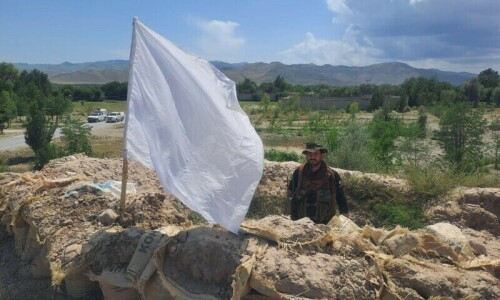KARACHI: An exhibition of ancient artefacts, contemporary potteries and interpretive artworks titled Harappan connections opened at the Gandhara Art Space on Thursday evening. Apart from being a photographic exhibition of Harappan artefacts that are part of the Lahore Museum’s permanent collection of the Indus Vallery Civilisation objects, the display also includes terracotta replicas made by Mohammad Nawaz and contemporary potteries of Sheherezade Alam, providing a link with the 5,000-year-old ceramic legacy as well as artworks made by students of fine art, design, archaeology, architecture, anthropology and history.
A significant advantage of travelling back in time through art is to understand the cultural indicators that have been a long standing (civilisational) pluralistic aspect of our region. The viewer notices it immediately by virtue of a drawing of ‘Shiv as master of animals seal’ by Samara Shahid. The sense of history is evoked on multiple levels, the foremost of which is the symbiotic relationship between deities and worshippers. The same section of the show contains images about burial customs, reinforcing the idea that cultural norms are not a static phenomenon; they keep changing and, in some cases, evolving.
Javaria Ahmad’s acrylic on paper depiction of a pot with an ibex, pheasant and goat is eye-catching. The artist’s tribute to ancient times is marked with skill and craft that brims with a fondness for yesteryear glory.
But at the heart of it all is renowned ceramist Sheherezade Alam’s work. Her pottery allows the viewer to have both a visual and tactile experience of a unique nature. No less intriguing are Mohammad Nawaz’s terracotta pieces, especially his storage containers.

Perhaps the most intriguing exhibit on display is the grand plan of Moenjodaro’s Great Bath copied by Jabran A. Tariq and Anosh N. Butt (graphite pencil and pen on tea-stained paper). It may point to a physical space, which experts believe was a tank that had a religious function, but there is a certain charm to the piece which, in the Aristotelian sense, turns it into a work of art surpassing the original. By the way, the copy of Moenjodaro’s site plan is no ordinary work either.

In terms of size, the viewer cannot miss the two big maps, one of which is about Indus sites and the other is to do with the legacies connecting the 3rd millennium BCE and 3rd millennium CE.
The exhibition will run until Jan 24.
Published in Dawn, January 15th, 2016













































